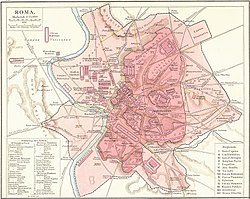Domus Aurea
| Location | Regione III Isis et Serap |
|---|---|
| Built in | c. 64-68 AD |
| Built by/for | Nero Claudius Caesar Augustus Germanicus |
| Type of structure | Roman villa |
| Related | List of ancient monuments in Rome |
The Domus Aurea (Latin, "Golden House") was a large landscaped portico villa built by the Emperor Nero in the heart of ancient Rome, after the great fire in 64 AD had cleared away the aristocratic dwellings on the slopes of the Palatine Hill.
Built of brick and concrete in the few years between the fire and Nero's suicide in 68, the extensive gold leaf that gave the villa its name was not the only extravagant element of its decor: stuccoed ceilings were faced with semi-precious stones and ivory veneers, while the walls were frescoed, coordinating the decoration into different themes in each major group of rooms.Pliny the Elder watched it being built and mentions it in his Naturalis Historia.
Suetonius claims this of Nero and the Domus Aurea:
When the edifice was finished in this style and he dedicated it, he deigned to say nothing more in the way of approval than that he was at last beginning to be housed like a human being.
Though the Domus Aurea complex covered parts of the slopes of the Palatine, Esquiline and Caelian hills, with a man-made lake in the marshy bottomlands, the estimated size of the Domus Aurea is an approximation, as much of it has not been excavated. Some scholars place it at over 300 acres (1.2 km2), while others estimate its size to have been under 100 acres (0.40 km2). Suetonius describes the complex as "ruinously prodigal" as it included groves of trees, pastures with flocks, vineyards and an artificial lake—rus in urbe, "countryside in the city".
Nero also commissioned from the Greek Zenodorus a colossal 35.5 m (120 RF) high bronze statue of himself, the Colossus Neronis. Pliny the Elder, however, puts its height at only 30.3 m (106.5 RF). The statue was placed just outside the main palace entrance at the terminus of the Via Appia in a large atrium of porticoes that divided the city from the private villa. This statue may have represented Nero as the sun god Sol, as Pliny saw some resemblance. This idea is widely accepted among scholars but some are convinced that Nero was not identified with Sol while he was alive. The face of the statue was modified shortly after Nero’s death during Vespasian’s reign to make it truly a statue of Sol.Hadrian moved it, with the help of the architect Decrianus and 24 elephants, to a position next to the Flavian Amphitheater. This building took the name "Colosseum" in the Middle Ages, after the statue nearby, or, as some historians believe, because of the sheer size of the building.
...
Wikipedia

